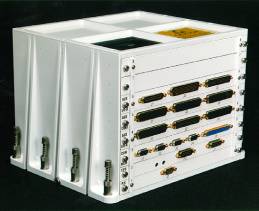
Data Processing Unit (DPU)
 The
DPU is one of two microprocessors aboard the UVOT. The DPU is responsible
for collecting data from the MIC detector, producing science telemetry
data products, compressing the data, and sending it to the Swift solid
state recorder.While
the ICU is a reimplementation of the XMM-OM ICU, this proved impossible
for the DPU because of parts availability. Southwest Research Institute
(SwRI), a leader in space applications, proposed that the DPU be implemented
on a radiation hardened RAD-6000 running the VxWorks real-time operating
system (RTOS). SwRI two flight DEMs in December 2001.
The
DPU is one of two microprocessors aboard the UVOT. The DPU is responsible
for collecting data from the MIC detector, producing science telemetry
data products, compressing the data, and sending it to the Swift solid
state recorder.While
the ICU is a reimplementation of the XMM-OM ICU, this proved impossible
for the DPU because of parts availability. Southwest Research Institute
(SwRI), a leader in space applications, proposed that the DPU be implemented
on a radiation hardened RAD-6000 running the VxWorks real-time operating
system (RTOS). SwRI two flight DEMs in December 2001.
Software
SwRI provided an application framework for use by programmers at Penn State who developed science data processing algorithms. In fact, a significant amount of software developed for the RAD-6000 on the Image project was reused for the DPU. For example, the bootstrap code used on Image was reused for the DPU with only minor modifications.
Electronics
The DPU must interface with three external hardware components: the spacecraft, the telescope module, and the ICU. To minimize changes in reimplementation of the ICU, the DPU used a Serial Synchronous Interface for communication between the ICU and the DPU as it was on XMM-OM. Data capture is also done as on XMM-OM with the exception that a Swift spacecraft timestamp is inserted in the event stream in place of a frame marker. Communication with the spacecraft uses the 1553B standard. SwRI has extensive experience with 1553 communications and was able to reuse 1553 code developed for Image with minimal changes. These three hardware interfaces were implemented by SwRI on a single board, the Swift Communications Module (SCM), and integrated into a single chassis along with the RAD-6000 and the ICU. The DEM chassis design has heritage from the Image mission.
Telemetry Data Products
The three basic science data products are finding charts, images and event lists. Images have a depth of 16 bits. The DPA software allows images to be windowed up to full 2048x2048 resolution. Exposures (images) longer than ~20 s will be drift corrected using the XMM-OM drift calculation software. Pointing stability of the spacecraft requires that drift correction be performed at least every 10 s. Images can be compressed before being sent to the solid state recorder.
Event lists will contain full 32-bit resolution events and 48-bit timestamps. One event window will be implemented in software. Hardware event windowing cannot be done with the UVOT detectors. Event data will be compressed before being sent to the solid state recorder.
During the last 10 arcminutes of a slew and up until the slew settle command is received from the spacecraft, the DPA will write spacecraft attitude control system (ACS) messages to the UVOT telemetry stream. The ACS messages will be used on the ground to determine which events came from candidate Gamma Ray Bursts. One requirement of the Swift mission is to send a finding chart to the ground withing 270 seconds of detection. We will have limited bandwidth on the TDRSS (high priority) channel, so finding chart images will first be parameterized into a source list. The list will contain image coordinates (in detector coordinates) and an intensity. Ground-based codes can be used to correlate the field against star catalogs to determine an accurate position of the GRB.
A finding chart is simply an image as described above. One of the science requirements of the UVOT is to telemeter a 8'x8' finding chart to the ground within TBD seconds. Since our bandwidth on the TDRSS channel is fairly low, so we cannot telemeter finding chart images within the alotted time, so we must parameterize the finding chart image to make a list of the brightest sources in the image. Each source will be parameterized into an (x,y) location (detector coordinates) and a 16-bit intensity. Finding chart images will be sent to the solid state recorder.
Swift Mission Operations Center
The Pennsylvania State University301 Science Park Road,
Building 2 Suite 332,
State College, PA 16801
USA
☎ +1 (814) 865-6834
📧 swiftods@swift.psu.edu
Swift MOC Team Leads
Mission Director: John NousekScience Operations: Jamie Kennea
Flight Operations: Mark Hilliard
UVOT: Michael Siegel
XRT: Jamie Kennea
Swift Partners
UK: UCL MSSL Univ. of LeicesterUSA: NASA/GSFC LANL Omitron SwRI
Italy: SSDC/ASI INAF OA-Brera